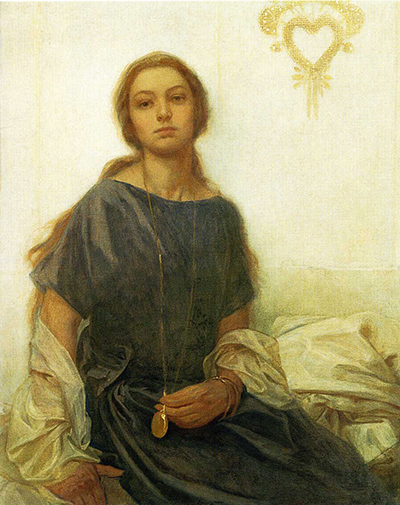This painting was produced in circa 1930 and now resides in the permanent collection of the Mucha Museum in Prague, Czech Republic. Jaroslava Muchová Syllabová would, therefore, have been in her very early twenties at the time that this portrait was completed.
Jaroslava was the daughter of the artist, and she would regularly pose for her father during her childhood and early adulthood. Eventually, she would become an artist herself and even carried out restorative work on some of her father's paintings which had become damaged, including some elements of his Slav Epic series. She featured in a number of both drawings and paintings produced by Alphonse, and even later on bank note designs. She was no doubt inspired by the success of her father's career and wanted to follow in his footsteps. Sadly, she would never reach the heights that he had done, but in helping to preserve her father's work for future generations, her role was nonetheless significant. The portrait in front of us here provides another element to the background information that we have on her life and Alphonse Mucha captured his family members many times within his career.
The young lady stares directly at us with a confident expression. She wears a small gold pocket watch around her neck which hangs down to her waist. Her left hand curls round to play with the top of the watch, where is meets the strap. She also wears several golden bracelets. Jaroslava wears a blue dress, fairly elegant, but does not wear any great amount of makeup which was common for the time. Her white bed sheets are wrapped around her arms, with the rest of the bed visible behind her. There is an interesting motif on the wall of her bedroom which features a heart with decorative touches of gold paint or glitter and the rest of the background is left entirely plain. It is therefore an honest depiction in which one can imagine this being her own bedroom in real life, rather than an attempt to over play the family's lifestyle.
The painting now can be found at the Mucha Museum in Prague, Czech Republic which is an excellent venue from which to learn more about this artist's greatest achievements. Whilst some of his work has been dispersed across Europe in a number of small private collections, it is always pleasing to be able to find so much of his career collated together under one roof. He is not just the most famous Czech artist, but also produced work which celebrated the region and also helped to educate the rest of us about elements of its history. It is therefore only right and proper that he enjoys an impressive institution devoted to his work and that he continues to be regarded as the face of the Art Nouveau movement.




